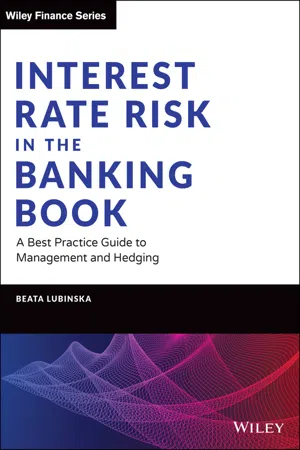
Interest Rate Risk in the Banking Book
A Best Practice Guide to Management and Hedging
- English
- ePUB (mobile friendly)
- Available on iOS & Android
Interest Rate Risk in the Banking Book
A Best Practice Guide to Management and Hedging
About this book
Introduces practical approaches for optimizing management and hedging of Interest Rate Risk in the Banking Book (IRRBB) driven by fast evolving regulatory landscape and market expectations.
Interest rate risk in the banking book (IRRBB) gained its importance through the regulatory requirements that have been growing and guiding the banking industry for the last couple of years. The importance of IRRBB is shifting for banks, away from 'just' a regulatory requirement to having an impact on the overall profitability of a financial institution. Interest Rate Risk in the Banking Book sheds light on the best practices for managing this importance risk category and provides detailed analysis of the hedging strategies, practical examples, and case studies based on the author's experience. This handbook is rich in practical insights on methodological approach and contents of ALCO report, IRRBB policy, ICAAP, Risk Appetite Statement (RAS) and model documentation. It is intended for the Treasury, Risk and Finance department and is helpful in improving and optimizing their IRRBB framework and strategy. By the end of this IRRBB journey, the reader will be equipped with all the necessary tools to build a proactive and compliant framework within a financial institution.
- Gain an updated understanding of the evolving regulatory landscape for IRRBB
- Learn to apply maturity gap analysis, sensitivity analysis, and the hedging strategy in banking contexts • Understand how customer behavior impacts interest rate risk and how to manage the consequences
- Examine case studies illustrating key IRRBB exposures and their implications
Written by London market risk expert Beata Lubinska, Interest Rate Risk in the Banking Book is the authoritative resource on this evolving topic.
Frequently asked questions
- Essential is ideal for learners and professionals who enjoy exploring a wide range of subjects. Access the Essential Library with 800,000+ trusted titles and best-sellers across business, personal growth, and the humanities. Includes unlimited reading time and Standard Read Aloud voice.
- Complete: Perfect for advanced learners and researchers needing full, unrestricted access. Unlock 1.4M+ books across hundreds of subjects, including academic and specialized titles. The Complete Plan also includes advanced features like Premium Read Aloud and Research Assistant.
Please note we cannot support devices running on iOS 13 and Android 7 or earlier. Learn more about using the app.
Information
Chapter 1
What is IRRBB and why is it important?

Table of contents
- Cover
- Table of Contents
- Titla Page
- Copyright
- Dedication
- Preface
- Introduction
- Chapter 1: What is IRRBB and why is it important?
- Chapter 2: How to identify and measure Interest Rate Risk in the Banking Book
- Chapter 3: How to manage IRRBB
- Chapter 4: Behaviouralisation of items without deterministic maturity and their impact on IRRBB
- Chapter 5: Interest rate risk and asset liability management
- Chapter 6: IRRBB stress test, reverse stress test and ICAAP
- Chapter 7: IRRBB governance and framework
- Appendix 1: Example of IRRBB policy aligned with the requirements of BCBS Standards
- Appendix 2: Example of IRRBB model manual
- References
- Index
- End User License Agreement